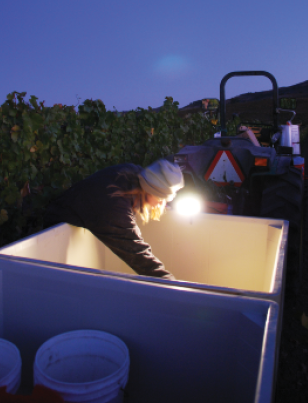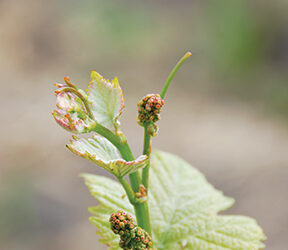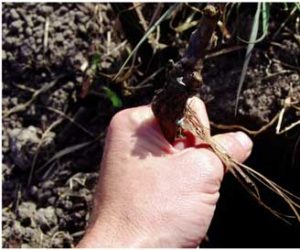 Anyone who’s ever heard me lecture on grape growing has heard these words more than once: “We only get one chance per year to harvest our vineyard and make wine. Make a plan and honor the time and effort you’ve spent in growing those grapes.”
Anyone who’s ever heard me lecture on grape growing has heard these words more than once: “We only get one chance per year to harvest our vineyard and make wine. Make a plan and honor the time and effort you’ve spent in growing those grapes.”
For the first 13 vintages at Clos Pepe Vineyards we harvested early in the morning, often for only a few hours until it got hot. Some days we were forced to keep working through afternoon heat and I believe the fruit and the wine suffered as a result. But it was common to have cool, foggy days through September and October and it was very rare to have heat spells that would keep us from harvesting from dawn until around noon.
Then we suffered under the heat wave of 2010 that arrived in late September/early October and persisted for ten days. We were seeing nighttime temperatures in the 40’s °F (5–9 °C) and daytime temperatures between 100–110 °F (38–43 °C). Our Pinot Noir ripened intensely in the heat. We went from 23 °Brix to 25 °Brix literally overnight, and in a meeting with my vineyard foreman, decided to strap some flood lights on the tractor, buy some headband-flashlights (aka miner’s lights) and have the crew come in at 2 a.m.
I still remember that first night. I tried to go to sleep in a sweltering house at 8 p.m., failed, and ended up just watching the clock until my alarm went off. I downed a cup or two of strong coffee, got my gloves and clippers and headed out to meet the crew. At first I was tired and a bit grumpy. But the cold fall air and the brilliant canopy of stars above us was the air conditioning we all needed after suffering under an oppressive heat. Time went faster, songs were sung, everyone seemed happy, and the dread of the coming sun was eliminated. It took a bit of concentration and adaptation to get used to a low-light environment.
I snipped my fingers twice the first night during the transition. Sorting the fruit in the field was also a bit more challenging, a few extra leaves ended up in the bin and we didn’t have lights at the haybarn where we stack filled grape bins, so that was a challenge as well. But the fruit was loaded up at 6:30 a.m. at 45 °F (7 °C). Zero volatile acidity, and the fruit was in amazing condition for being harvested in the worst harvest heat wave I’ve ever seen. Vintage saved!
That was five harvests ago. Since that time we have seen a serious (if not massive) shift in Santa Barbara Wine Country (and all over California and the world) to night harvesting winegrapes. Let’s discuss the benefits and potential problems and then talk about how we can tweak your operation to make night-harvesting your backyard vineyard a reality. Brew some coffee and let’s get to it!
NIGHT HARVESTING BENEFITS AND SUGGESTIONS
• Make a plan. You know the drill. With your wine’s style and quality “locked in” at the moment of harvest, choosing the right night to bring the fruit in is the most important winemaking decision you will ever make. I understand you have a job, kids, grandkids, etc. But winemaking is an ancient and worthy craft that requires your total commitment for just one night of picking and crushing. Don’t calendar it weeks, or even days out. Make a plan so you can pull the trigger on the perfect night every time. Weather changes fast — be ready. If you don’t have a huge threat of sunburn, do a deep leafing around the fruit area the evening before the pick to make seeing the clusters at night easier.
• Test your fruit at night, as Brix can dip a bit. This is something that caught me by surprise a few times. During times of heat stress, the vine repairs and rests at night. I have seen an afternoon fruit sample pulled in a heat wave at 27 °Brix and 3.6 pH and then the grapes that came in that night were lab-tested at 25.5 °B and 3.4 pH. What happened? The vines were being irrigated during the heat wave to mitigate raisining, so the vine was able to pull up some water at night, dilute the Brix slightly, and the night was cold, which does seem to help pull the pH back a bit and give better acidity. Was it a bad sample? While it’s true most fruit samples come in a bit riper than what the final harvest chemistry shows (humans automatically select for ripeness visually), I’m really good at pulling accurate samples, and I will expect Brix to drop a bit at night and for acid to recover, especially if your nights are cold.
• Prepare your equipment. Do you have enough headlamps for everyone coming, and a few extras for light failure, batteries dying, or the unexpected help of Aunt Petunia? Fresh batteries for your headlamps are a must, replacing them each harvest in a backyard vineyard seems a perfect way to guarantee brightness. Cotton gloves are available at most hardware or garden centers. Have a few different sizes for the pickers. Five-gallon (19-L) plastic buckets are fine to pick into and transport the fruit. Some people love those yellow grape-picking trays that stack. Harvest snips are what you want to use for picking, not pruning shears.
A way to move the fruit from the vineyard into the winery is helpful too. Some can use a pickup truck if you can maneuver it into those areas, some use an ATV, mini-tractor, or even a wagon. Most commonly, the strongest, youngest picker(s) should plan on lugging two buckets at a time into the area where the crusher-destemmer will start the production. Having one or two people moving buckets and providing fresh ones is key. Have at least one bucket for every 25 lbs. (11 kg) of fruit you plan to harvest, or have the buckets delivered to be crushed/destemmed and the buckets brought back out into the field. A sorting table may be too much to ask, but the crusher should be set up in a way that you can see each cluster in the bucket before it goes into the hopper so MOG (material other than grapes) can be removed before it’s in a piece of machinery that takes dozens of fingers and hands each year. Never reach into a crusher for a leaf. That’s bush league not to have the fruit sorted before it’s near a dangerous, grinding steel auger. If you want some horrific pictures of industrial wine accidents, let me know.
• Provide extra light. Commercial vineyards usually put light racks on their tractors, or rent generators/floodlights and move them to the area of harvest. Be creative in putting extra light on the vineyard. Consider adding floodlights as close as can be clipped or installed to your rows, park a truck/ATV with good headlights where you are harvesting, or check with a rental company to get a generator with floodlights delivered for a night. Identify dangerous areas (animal burrows, erosion areas, etc.) to keep liability down and ankles from breaking.
• Get your crew together. How many folks do you need to get the vineyard picked efficiently? A young, hustling picker with no experience can pick at least 100 pounds (45 kg) per hour. Aunt Petunia will be lucky to get two buckets before the vineyard is empty. Amateur pickers usually lose their will to work after 2-4 hours depending on the climate and how much wine they drank before going out. I like a minimum picking crew of four, and if your vineyard will produce 1,000 pounds or more, add a few folks for sure. For more than an acre you can go to 10. Try to keep folks relatively sober (sharp implements and all!), and we offer free 5-Hour Energy or espresso to our crew to keep them lively. Have four people working each row, two on each side and separated by at least 3–4 vines to keep them from leap-frogging every few minutes. Also tell the person last in the row to check for missed clusters as they move forward. And if they’re highly caffeinated, they may stick around to help make the wine, and (gasp!) clean up as the sun comes up.
• Enjoy the cool of night and improved wine quality. Consider crushing and destemming at night too.
As an important aside, here’s my “Golden Rules of Harvest” that I announce every night in a loud voice to my crew before we start picking:
• Never cut what you can’t see — because usually it’s your finger.
• Punish the vine, pamper the clusters. This means the pickers should pull and push on the canes to get a better position to clip out the bunches. You’re going to prune 90% of the canes off a vine, so thrashing the vine a bit to get at the fruit is perfectly fine.
• Never yank on the clusters to get a better position on the stem. If berries are falling off the cluster then you are being too rough.
• Don’t pick any green fruit. You will have to show the pickers an example of a cluster that is appropriate for picking and one that isn’t. (Show rot, mildew, unripe fruit, and the difference between a primary and a second-crop cluster.)
In general, we only make wine from primary clusters and you do not use second crop (those small clusters high in the canopy). If you have tons of second crop, wait a few weeks until it’s 23+ °Brix on average and make a carboy of rosé.
• Never push down on the clusters in your bucket to make more room. Clusters should arrive at the crusher/press in pristine condition.
• Only pick clusters that look good enough to eat right off the vine. If a tiny bit (I usually say a quarter or less) of an otherwise clean cluster is messed up, cut off the bad part and toss the good part in the bucket.
• NEVER place your snips in your bucket, and on that note never place any material other than grapes into the bucket. Everything in the bucket goes into an expensive piece of machinery. Some of the more interesting objects I’ve kept from sliding into the crusher: Burritos, cell phones, pocket knives, small coolers, a gopher snake, and a soiled Band Aid.
• Clip bad clusters onto the vineyard floor and leave them there so they don’t overwinter and add to mildew/rot pressure next year. A clean cluster dropped on the ground can be picked up, blown off, and put into the bucket.
• Watch for bees and stinging insects on the backs of
clusters. They sometimes spend the night there.
• Be careful walking with full buckets. It’s very easy to hit a bump or hole and sprain an ankle.
• If you need a bucket, a new pair of snips, or a Band-Aid let me know.
NIGHT HARVESTING ISSUES TO CONSIDER
• Overcompensate with lighting.
• Have plenty of Band-Aids ready.
• Have someone with good lighting sorting your fruit on the bin or in the winery.
EQUIPMENT THAT I TRUST
• 5-gallon (19-L) buckets or grape picking trays.
• High intensity LED headlamps. They often come in three- or five-packs! Buy plenty of extra batteries. If there is a choice, go for the highest lumens and I prefer lights that take AA batteries, not AAA.
• Cotton gloves. Various sizes will be needed for your pickers. They are much cheaper by the dozen at farm supply stores or the Internet.
• Comfortable clothing and shoes. I wear layers so I can shed or add in warm or cold nights.
• Harvest snips (not pruning shears!). I prefer Bahco 71⁄2-inch (19 cm) Harvesting Snips P128-19 at about $12/pair. See if you can get a good deal on a dozen. Give them a rubdown with WD-40 after harvest and keep them safe and they should last you at least 3–4 harvests.
• Rented flood lights or lights on an ATV, backyard mounted, truck bed, etc. Remember, the more lighting you have around you in the vineyard the easier and safer your night harvesting will be.
• A knowledgeable winemaker running the crusher. This is someone who won’t lose a finger and will sort the fruit carefully and safely as it comes in from the field.
Conclusion
Harvesting at night makes better wine. The must will start up to 40 °F (22 °C) cooler with less volatile acidity and far less chance of spontaneous fermentation. Night harvest reduced my need for dry ice at the crusher and also reduced the amount of SO2 I add pre-fermentation. Most importantly, I have seen an increase in wine quality from night-harvested fruit. My promise: Once you pick grapes under the stars you’ll wonder why you ever did it under the hot, unrelenting sun. Have fun and send me your night-harvesting pictures and experiences via email: [email protected].







